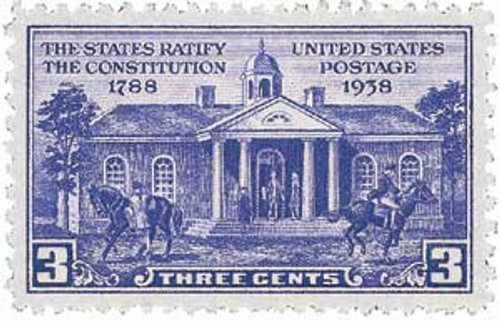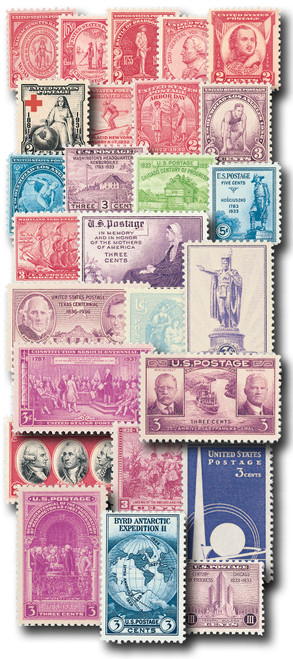
1938 3c Constitution Ratification
# 835 - 1938 3c Constitution Ratification
$0.35 - $60.00
U.S. #835
3¢ Constitution Ratification
3¢ Constitution Ratification
Issue Date: June 21, 1938
City: Philadelphia, PA
Quantity: 73,043,650
Printed by: Bureau of Engraving and Printing
Printing Method: Rotary Press
Perforations: 11 x 10.5
Color: Deep violet
City: Philadelphia, PA
Quantity: 73,043,650
Printed by: Bureau of Engraving and Printing
Printing Method: Rotary Press
Perforations: 11 x 10.5
Color: Deep violet
U.S. #835 commemorates the 150th anniversary of the ratification of the Constitution. At least nine of the 13 original states had to approve before it could be placed into affect. New Hampshire’s vote on June 21, 1788, secured the Constitution as America’s primary governing document.
Ratifying the Constitution
Following the 1787 Constitutional Convention in Philadelphia that created the new nation’s Constitution, each state had to ratify (approve) it individually. The first nine states approved the Constitution by June 1788. Although all that was needed to approve the Constitution was nine states, four others argued that it provided too much power to the central government, which could easily abuse individual rights. They believed there should be a bill of rights to prevent such abuses.
Some of those who supported the Constitution as it was included James Madison, Alexander Hamilton, and John Jay, who together published the Federalist Papers. These papers explained how such a government benefited all Americans.
When Congress met for the first time in 1789, they received more than 145 suggestions for amendments. Congress reduced this to 12 by the time they submitted the amendments to each state for their consideration. While the states were considering and voting on the amendments, the final state ratified the Constitution in 1790. The following year, the states selected the 10 amendments that were added, known as the Bill of Rights.
FDR – The Stamp-Collecting President
President Franklin Roosevelt was instrumental in the design and issuance of U.S. #835. Introduced to stamp collecting at a young age by his mother, Franklin Delano Roosevelt turned to his collection throughout his life to relax and unwind.
Elected President four times, Roosevelt served in the nation’s highest office longer than any other chief executive – 12 years. During those 12 years, Roosevelt shared his love of stamps with the nation, personally approving each of more than 200 stamp designs. He suggested topics, rejected others, and even designed some himself. It was his aim to use stamps not just to send mail but also to educate Americans about our history. And as he reluctantly entered America into World War II, he saw these stamps as an outlet to raise spirits and bring hope.
U.S. #835
3¢ Constitution Ratification
3¢ Constitution Ratification
Issue Date: June 21, 1938
City: Philadelphia, PA
Quantity: 73,043,650
Printed by: Bureau of Engraving and Printing
Printing Method: Rotary Press
Perforations: 11 x 10.5
Color: Deep violet
City: Philadelphia, PA
Quantity: 73,043,650
Printed by: Bureau of Engraving and Printing
Printing Method: Rotary Press
Perforations: 11 x 10.5
Color: Deep violet
U.S. #835 commemorates the 150th anniversary of the ratification of the Constitution. At least nine of the 13 original states had to approve before it could be placed into affect. New Hampshire’s vote on June 21, 1788, secured the Constitution as America’s primary governing document.
Ratifying the Constitution
Following the 1787 Constitutional Convention in Philadelphia that created the new nation’s Constitution, each state had to ratify (approve) it individually. The first nine states approved the Constitution by June 1788. Although all that was needed to approve the Constitution was nine states, four others argued that it provided too much power to the central government, which could easily abuse individual rights. They believed there should be a bill of rights to prevent such abuses.
Some of those who supported the Constitution as it was included James Madison, Alexander Hamilton, and John Jay, who together published the Federalist Papers. These papers explained how such a government benefited all Americans.
When Congress met for the first time in 1789, they received more than 145 suggestions for amendments. Congress reduced this to 12 by the time they submitted the amendments to each state for their consideration. While the states were considering and voting on the amendments, the final state ratified the Constitution in 1790. The following year, the states selected the 10 amendments that were added, known as the Bill of Rights.
FDR – The Stamp-Collecting President
President Franklin Roosevelt was instrumental in the design and issuance of U.S. #835. Introduced to stamp collecting at a young age by his mother, Franklin Delano Roosevelt turned to his collection throughout his life to relax and unwind.
Elected President four times, Roosevelt served in the nation’s highest office longer than any other chief executive – 12 years. During those 12 years, Roosevelt shared his love of stamps with the nation, personally approving each of more than 200 stamp designs. He suggested topics, rejected others, and even designed some himself. It was his aim to use stamps not just to send mail but also to educate Americans about our history. And as he reluctantly entered America into World War II, he saw these stamps as an outlet to raise spirits and bring hope.











